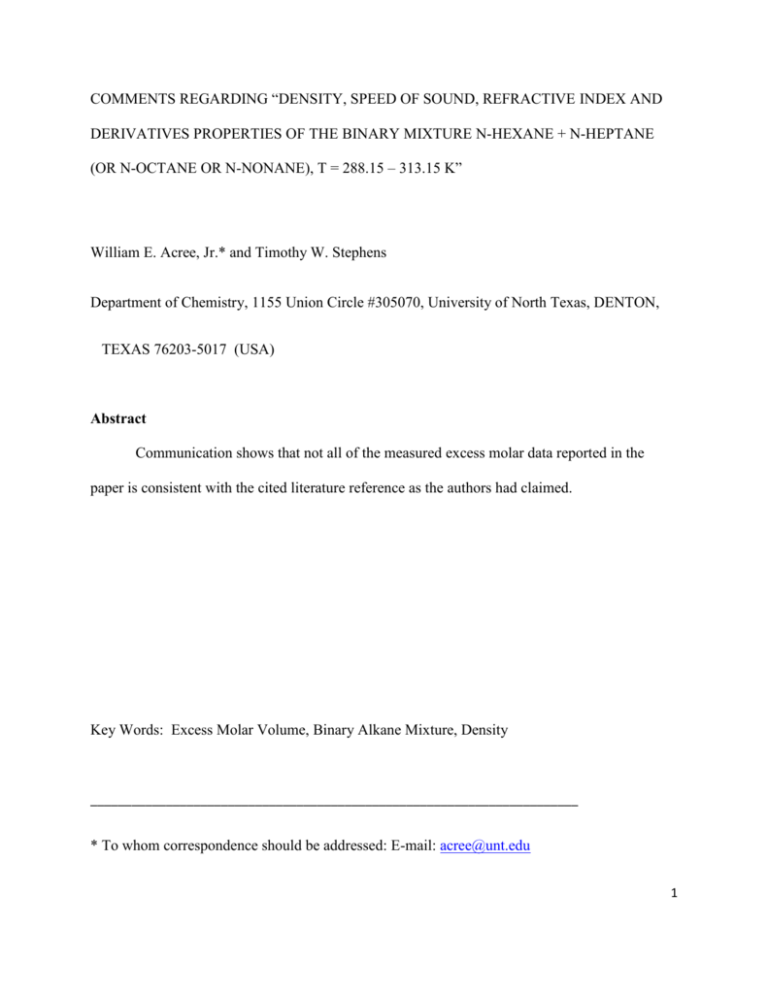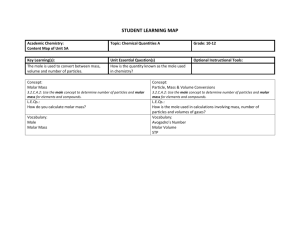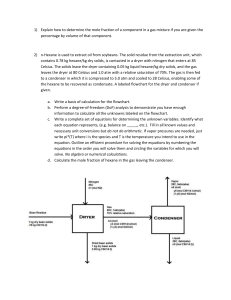COMMENTS REGARDING “DENSITY, SPEED OF SOUND
advertisement

COMMENTS REGARDING “DENSITY, SPEED OF SOUND, REFRACTIVE INDEX AND DERIVATIVES PROPERTIES OF THE BINARY MIXTURE N-HEXANE + N-HEPTANE (OR N-OCTANE OR N-NONANE), T = 288.15 – 313.15 K” William E. Acree, Jr.* and Timothy W. Stephens Department of Chemistry, 1155 Union Circle #305070, University of North Texas, DENTON, TEXAS 76203-5017 (USA) Abstract Communication shows that not all of the measured excess molar data reported in the paper is consistent with the cited literature reference as the authors had claimed. Key Words: Excess Molar Volume, Binary Alkane Mixture, Density _______________________________________________________________________ * To whom correspondence should be addressed: E-mail: acree@unt.edu 1 In a recent paper published in this journal Blanco and coworkers [1] reported experimental values of the refractive index nD, density ρ, speed of sound u, isentropic compressibility Ks, excess molar volume of mixing Vex, and deviations of both the refractive index δnD and isentropic compressibility δKs of binary hexane + heptane, hexane + octane and hexane + nonane mixtures from 288.15 K to 308.15 K. Physical and thermodynamic properties of binary mixtures of alkanes have been measured many times in the past. For many of the binary alkane mixtures one can readily find experimental data in the published literature to compare newly measured values against. In fact in the last paragraph of the results and discussion section the authors stated “if you do a comparison of the experimental data with the literature, it is consistent with the bibliography [2].” The purpose of the present communication is to perform the suggested comparison, which will show that not all of the experimental excess molar volume data in the authors’ paper is consistent with the cited published literature data as the authors claim. Goates and coworkers [2] measured the excess molar volumes of binary hexane + heptane, hexane + octane, hexane + nonane, and hexane + decane mixtures at 283.15 K, 298.15 K and 313.15 K using a vibratingtube densimeter. For the binary hexane + heptane system the excess molar volumes reported by Goates and coworkers were: Vex = -0.0198 cm3/mole at xhexane = 0.4948 and 283.15 K; Vex = 0.0291 cm3/mole at xhexane = 0.4877 and 298.15 K; and Vex = - 0.0396 cm3/mole at xhexane = 0.5006 and T = 313.15 K. Blanco and coworkers report in Figure 4 (diamond symbol) a value on the order of Vex = -0.60 cm3/mole at 308.15 K, which differs significantly from the previously published data of Goates and coworkers. The measured data for the other two binary systems are in much better agreement: Vex = - 0.12 cm3/mole at 303.15 K versus -0.11 cm3/mole at 308.15 K for the binary hexane + octane system near xhexane = 0.50; and Vex = -0.15 cm3/mole at 298.15 K 2 versus Vex = -0.15 cm3/mole at 298.15 K near xhexane = 0.50. To state “it is consistent with the bibliography [2]” is misleading and totally ignores the large deviations noted in the binary hexane + heptane system. A search of the published chemical and engineering literature found three additional sets of experimental excess molar volume data for binary hexane + heptane mixtures measured at 298.15 K. Kimura and Benson [3] determined excess molar volumes using a successive dilution micrometer syringe dilatometer, Touriño et al. [4] and Saito and Tanaka [5] both measured the excess molar volumes with a vibrating-tube densimeter. It is possible to compare the recently published data of Blanco and coworkers at 298.15 K to the available literature data. Blanco and coworkers reported their experimental excess molar volume data in the form of the RedlichKister equation: m V ex x1 x 2 B p ( x1 x 2 ) p p 0 (1) with the temperature-dependent curve-fit equation coefficients given by 2 B p B pqT q q 0 (2) Substituting the numerical values of the curve-fit parameters given in Table 3 of the Blanco et al. paper for the binary hexane + heptane system into Eqns. 1 and 2, one obtains the following Redlich-Kister equation: Vex = x1x2 [-2.356 – 0.946 (x1 – x2) – 0.543 (x1 – x2)2 – 0.255 (x1 – x2)3 + 4.601 (x1 – x2)4] (3) for calculating the excess molar volumes at 298.15 K. 3 In Table 1 and Figure 1 we have compared the calculated Vex values based on Eqn. 3 to the experimental values of Goates and coworkers [2], Kimura and Benson [3], Touriño et al. [4], and Saito and Tanaka [5]. Examination of Figure 1 and the numerical entries in Table 1 reveals that the experimental excess molar volume data reported by Blanco and coworkers for the binary hexane + heptane system differs significantly from all four sets of published literature data, and that the four sets of published literature data are in good agreement with each other. Given the large deviations noted in Figure 1, readers may wish to exercise caution in using the binary hexane + heptane Vex data of Blanco and coworkers. We also note that the discussion pertaining to excess molar volumes given by Blanco and coworkers is incorrect. For example, the authors state “If the interactions between the molecules of two mixed components are weaker than in the pure component, the excess volume will be negative, as occurs for the studied mixtures. This usually occurs when all the components have polar groups.” The effect is just the opposite. Negative excess molar volumes are often observed in mixtures where molecular association is believed to occur between the two dissimilar mixture components, such as in the case of binary chloroform + triethylamine [6] and chloroform + dialkyl ether [7] mixtures. Here the interactions between the two mixed components are stronger than in the pure components, not weaker as the authors stated. Packing and molecular shape are other factors contributing to the excess molar volume. References [1] A. Blanco, A. Gayol, D. Gómez-Díaz and J. M. Navaza, Phys. Chem. Liq., in press (2013) DOI:10.1080/00319104.2012.760086. [2] J. R. Goates, J. B. Ott and R. B. Grigg, J. Chem. Thermodyn. 13, 907-913 (1981). 4 [3] F. Kimura and G. C. Benson, J. Chem. Eng. Data 28, 387-390 (1983). [4] A. Touriño, M. Hervello, V. Moreno, M. Inglesias and G. Marino, Phys. Chem. Liq. 42, 37-51 (2004). [5] A. Saito and R. Tanaka, J. Chem. Thermodyn. 20, 859-865 (1988). [6] A. Chand, Y. P. Handa and D. V. Fenby, J. Chem. Thermodyn. 7, 401-402 (1975). [7] L. A. Beath, S. P. O’Neill and A. G. Williamson, J. Chem. Thermodyn. 1, 293-300 (1969). 5 Table 1. Comparison of Experimental Excess Molar Volumes of Binary Hexane (1) + Heptane (2) Mixtures at 298.15 K Determined by Independent Research Groups ______________________________________________________________________________ Vex (cm3/mole)a xhexane Ref. [1] Ref. [2] Ref. [3] Ref. [4] Ref. [5] ______________________________________________________________________________ 0.100 0.006 -0.009 -0.009 0.0002 -0.009 0.200 -0.213 -0.017 -0.016 0.0003 -0.016 0.300 -0.405 -0.023 -0.022 0.0004 -0.021 0.400 -0.523 -0.027 -0.026 0.0005 -0.025 0.500 -0.589 -0.028 -0.028 0.0005 -0.026 0.600 -0.615 -0.027 -0.027 0.0005 -0.024 0.700 -0.571 -0.024 -0.024 0.0004 -0.021 0.800 -0.412 -0.018 -0.019 0.0003 -0.016 0.900 -0.154 -0.010 -0.011 0.0002 -0.009 ______________________________________________________________________________ a Calculated using the Redlich-Kister equations given in the respective papers. 6 Figure 1 Figure 1. Comparison of the experimental excess molar volumes, Vex (cm3/mole), determined by Blanco et al. (), Goates et al. (), Kimura and Benson (), Touriño et al. (), and Saito and Tanaka (). 7







